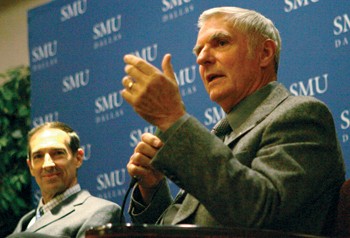
Dick Rutan, record holder for the fastest nonstop flight around the world (right), answers questions from students during the Tate Student Forum while SpaceShipOne pilot Brian Binnie (left) looks on. (John Schreiber)
Brian Binnie, astronaut and pilot of SpaceShipOne, the first civilian craft to successfully make it outside of the Earth’s atmosphere, along with Dick Rutan, pilot of Voyager, the first aircraft to complete a nonstop flight around the world without refueling, were the distinguished guests of Tuesday’s Dan and Gail Cook Lecture of the Willis M. Tate Lecture series. The men discussed their personal experiences as aviation pioneers and also discussed the future of civilian space travel.
Binnie was a naval aviator for 20 years serving in both Desert Shield and Desert Storm. Rutan flew 325 missions over Vietnam, retiring from the Air Force in 1978. He earned a Silver Star, five Distinguished Flying Crosses, 16 Air Medals and a Purple Heart. His brother, Burt Rutan, founder of Scaled Composites, the aerospace company that developed SpaceShipOne and worked with him on Voyager could not make it to the lecture, but was there in absentia given the prolific amount of attention and praise the speakers gave him.
Speaking on how it was that they were able to achieve their accomplishments, Rutan said, “It’s because of Burt, his vision, his courage.”
Rutan described the state of civilian experimental aviation in the 1980s and through video presentations, detailed the struggles involved in getting Voyager off the ground. One of the biggest struggles therein was literal, as he took off with over 3.6 tons of fuel, and the craft weighed so much that the wings dragged along the ground at Edwards Air Force base’s Runway Four, the longest runway in the world at three miles long.
Miraculously, the aircraft gained enough speed to become airborne and would begin its journey of over 26,000 miles. Shortly into the flight, the wingtips of both wings were shredded off of the airframe. Rather than abort after five and a half years of development, Rutan recalled, “My mother always said: If you dream it, you can do it and the only way you can fail is if you quit… There was no way around it now, we were airborne and on our way around the world.”
Reflecting on the challenges of the flight, he told the audience, “I think if I had known what was going to happen over the next nine days, I would have bailed out.” In remarking on the various challenges and misunderstandings paired with a flight around the world, he told the audience half-jokingly, “They threatened to shoot me down over Vietnam- again.”
Filled with praise for his brother and the accomplishments of their own aerospace achievements and innovations, he completed his half of the lecture by invoking the words of Werner Von Braun, “The greatest challenge is not the mechanical aspects but finding the courage to try.”
Binnie went a different direction than Rutan, who was straight and to the point. He described various achievements and innovations of the last 50 years and described their impact on mankind. He saw reaching goals and breaking records as having a profound cultural effect in inspiring others to meet the same challenges.
“In this day and age… this country I would say is becoming risk averse. We spend more money on lawyers or avoiding lawyers than on science or research,” he said. He described how Dick Rutan’s brother Burt, his boss, ran his company differently and with enthusiasm.
“We built stuff that looked good in Burt’s mind and if it looked promising, we’d develop it,” he said of the various endeavors of the Scaled Composite company.
He described the differences in NASA’s development of the space shuttle and of SpaceShipOne.
“We were looking for simple, safe, effective [solutions].” He detailed in particular the decision not to develop space suits for the flight. He defended the decision saying, “You only get four minutes [of weightlessness], and you don’t want to knock your head around in a space suit.”
Binnie took a few minutes to describe his four minutes in space, “You literally step into a realm of peace and quiet, you can just unbuckle yourself and all you have to do is think about it and you drift towards the window.” He said of the view of Earth, “it’s as though someone’s pulled back the curtain for your eyes only.”
Earlier in the day, both men fielded questions from over 300 students from SMU and surrounding high schools. They described their enthusiasm about the future of civilian space travel.
When asked by an audience member about recreational space travel, Binnie answered, “The market’s already been there for two years. I don’t think [cheap travel] is far away at all. I think it’s past the point of speculation, it is going to happen. We’re currently working on SpaceShipTwo and we’re very much looking forward to seeing you come aboard.”









